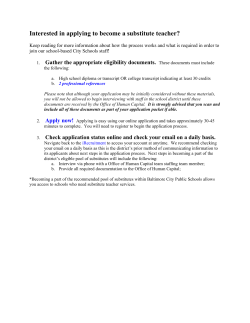
Why Transcripts Are Crucial for Home-Schooled High School Graduates
Why Transcripts Are Crucial for Home-Schooled High School Graduates By Inge Cannon, Education PLUS There is no question that home education is growing in popularity across the United States. Current estimates place the number of home-schooling families somewhere around 500,000, meaning that parents are home schooling at least two million children. Surveys indicate that up to thirty percent of those students are teens. As the high school "enrollment" in home education has grown, so have the questions: e.g., Where does one get a high school diploma? Can parents graduate their own children? How do colleges respond to home school records? If a high school diploma does not come from an accredited school, does that hurt the future education and job prospects for the graduate? Surprisingly, the answers to these questions are not only positive, they are also much easier to implement than most parents suspect. The source of a home school high school diploma is the teaching parent(s). No matter where you attend school, your diploma is granted by the people who supervised your educational program. Therefore, unless a student is enrolled in a correspondence school, the home-schooling parent would have to accept the responsibility for issuing a diploma and ultimately certifying the student's status as a graduate. (Obviously, a correspondence program takes full responsibility for directing your curriculum, evaluating work that is done, providing records, and thus issuing the diploma. Examples include Christian Liberty Academy, The Academy of Home Education at Bob Jones University, The American School, etc.) The following simple steps will position home-educating parents to grant diplomas to their graduating high school students. [1] Fewer than a half dozen states specify any restrictions within their education regulations about who may grant a diploma. Check with the Home School Legal Defense Association at www.hslda.org to learn if your state is one with restrictions. [2] If you know that your graduate is college-bound, check with the admissions office(s) of the school(s) of your choice to identify their requirements or guidelines. (Note that these requirements don't have to be included in your program in order to issue a diploma.) [3] Summarize your record keeping with a carefully prepared transcript. [4] Prepare a written diploma. HSLDA offers a beautiful form in a leatherette case with an attractive gold seal at a very economical price—all you have to add is the calligraphy! Contact them at www.hslda.org. Another option is the personalized attention available at www.homeschooldiplomas.com. [5] Plan a special event to honor this milestone in your child's life. But will that diploma be recognized everywhere you go? It may shock you to learn that there are no legal requirements for any school to recognize another school's credits or program. Throughout the nation accrediting associations have been formed to pave the way for reciprocity between member schools, and most states have some means of listing the "bona fide" schools recognized by their administrative offices. However, these identifications do not guarantee that all work a student has done in one institution will be fully accepted by another. In other words, any student who knocks on a college admissions door can be asked to provide documentation of the scope of academic requirements, pass placement tests particularly in subjects like English, math, or foreign language, and even submit results of a GED to guarantee equivalency if their school is not a "recognized" one. One extremely encouraging fact to remember is that 15 hours of college credit validates any high school diploma. With distance education opportunities flourishing, the challenge of earning these credits is becoming more achievable all the time. Thorough documentation of a student's academic record on a transcript makes the diploma meaningful. When you prepare your annual tax return for the federal government, you summarize all pertinent financial information on the appropriate form(s). You are not asked to send cancelled checks, interest statements, and detailed backup documentation. But this information has to be available should you experience an audit of your return. In a sense, a student's high school transcript is like that tax return. It summarizes and reports in a concise way the total educational profile of the student's experience. Behind that transcript should stand a portfolio of work samples, bibliography of resources used, detailed test information, anecdotal records, recommendations from employers and directors of extracurricular activities, etc. This further documentation would then be available for any interview where it might become necessary. Every home-educating program must complete a transcript and diploma for its graduating students whether or not they are considering college enrollment. Many parents have the impression that transcripts are useful only if a student desires college enrollment. While that certainly is the primary function of the high school credential, there are other benefits tied to the important responsibility of documenting high school achievement. Here are just a few of them: [1] Good Driver Discounts on Insurance If you will keep up with your record keeping responsibilities so that your transcript is always current, you will be able to use it as a conventional high school student would use his/her report card. Most insurance companies grant a discount to young drivers who maintain a B-average. [2] Employer Screening and Security Clearance In the absence of significant work experience in the marketplace, many employers request high school (and later college) transcripts to document skills and background that will be valuable in their workplace. Don’t make the mistake of thinking that this need will disappear when your student finishes a college degree. Since the tragic events of September 11, 2001, it is not unusual for an employer to require the high school transcript as a form of security clearance—proof that you are the person you claim to be. We met a gentleman in Ohio recently who had earned a Ph.D. in Physics and was starting a new position the following week. He told us at the seminar that he could not begin that job until he submitted his high school records. [3] Elimination of the Requirement to take a GED The letters GED are the acronym for “General Educational Development Test.” This assessment is a special tool originally designed to allow soldiers who had not finished high school to qualify for college tuition assistance under the GI Bill. Since the inception of the GED assessment program, many young adults have taken advantage of the opportunity to “prove” their achievement of equivalent high school mastery after dropping out of their school responsibilities as teens. Other young people take the GED in order to eliminate their attendance requirements—in fact, some home educators have used this tool to avoid the high school record keeping responsibilities that are attached to the compulsory attendance laws in every state. I am not enthusiastic about the GED option for a home-educated student to document his/her graduation. This test is actually a measurement tool to assess mastery of the equivalent of high school training in “the school of hard knocks”— by way of “street smarts,” rather than by documentation of disciplined academic pursuits. The bottom line is that a diploma earned by way of the GED tends to carry the stigma of the “high school dropout.” I believe that the tutorial advantage of home education does so much more for a student that it is sad to see parents sell their young people short by granting a GED equivalency diploma. There are unfortunately some situations where a college may require a home school graduate to verify his credential by taking a GED. If you find yourself in such a position, then use the test to satisfy that admission requirement—but don’t grant your high school diploma based upon this test score. It is much to your children’s long-term advantage to earn a diploma based upon a well-written high school transcript! © Education PLUS, A Division of The Cannon Group, Inc., 2004. All rights reserved. Inge Cannon has been in the business of helping parents translate everything they do in their home schools into “educationese” for more than 20 years. Her own background as a teacher, principal, college dean/professor, curriculum developer, and lobbyist for parental rights in education has prepared her well for the production of TranscriptPro, a special software program that makes transcript production easy and accurate. TranscriptPro will not provide you with mere templates—instead it works as a wizard to guide you through the necessary data entry process one step at a time until you reach the final goal of professional presentation. Inge’s CreditPro card system for keeping time logs will enable you to delegate important record-keeping responsibilities to your student, and if you need more help, Inge’s Transcript Boot Camp on DVD is available to answer just about any question you can imagine! Don’t procrastinate—the best time to hear this seminar is when your oldest child turns 11! Details are available at www.homeschooltranscripts.com.
© Copyright 2025





















